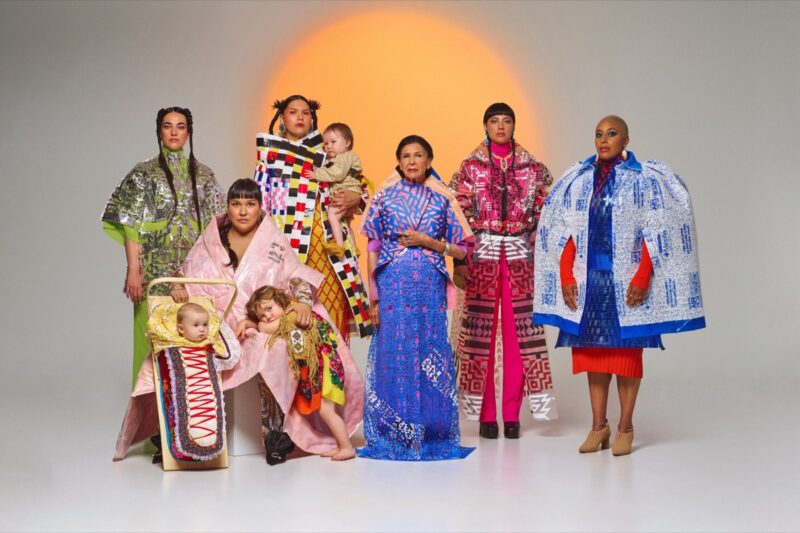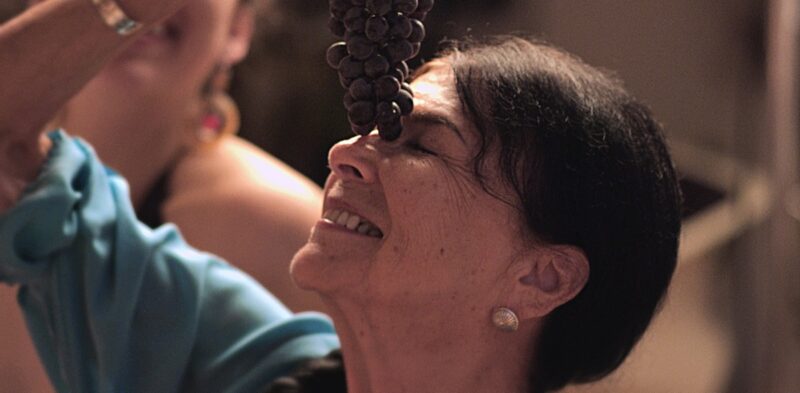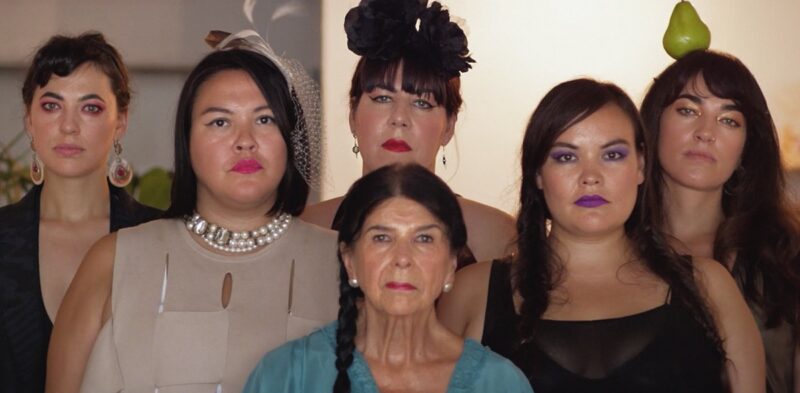[Fall 2024]
Living Here: A Voice for Indigenous Women
by Caroline Nepton-Hotte
[EXCERPT]
Offering a space for connection, in complete safety, affirming an immemorial presence – this is what the multidisciplinary artist and filmmaker Caroline Monnet has done in her photographs and films. Monnet, whose ancestry is Anishinaabe and French, sets out to create sites of resistance for Indigenous women. The works Creatura Dada (2016), Emptying the Tank (2018), History Shall Speak for Itself (2018), Debouttes! (2022), and Echoes From a Near Future (2022) bespeak her desire to put an end to the discrimination against them both in society and in the film and art worlds.1 Celebrating the agency and power of her sisters from various First Nations, Monnet blurs the edges of representation with an aesthetic that confronts received ideas about colonial history. As cultural studies researcher Pedro Pablo Gómez notes, “Aesthetic decoloniality is concerned with bringing to light historical practices of resistance.”2 By offering spaces of contestation against dominant discourses of the colonial past that are perpetuated today, Monnet challenges the canonical history of the visual arts in Canada by inviting us to change how we look at Indigenous women, and she participates in the resurgence of the First Nations of Canada by celebrating Indigenous voices, memories, and expertise long banned by the colonial state. Translated by Käthe Roth
Beyond the government policies that banned Indigenous peoples from performing many of their cultural practices, the stereotypes were kept alive in art, cinema, and the media, and Indigenous women, in particular, were made invisible. Hollywood movies, documentaries, and photographs objectivized them, showed them frozen in a reified past, or hypersexualized them. These portrayals opened the door to the perpetuation of brutal violence, as the National Inquiry into Missing and Murdered Indigenous Women and Girls has shown.3 Camera in hand, Monnet reclaims the public space by using media techniques to reverse the power dynamic by (re)presenting these women and using her voice to highlight their knowledge.
In the video Creatura Dada, produced in 2016 for the 45th edition of the Festival du nouveau cinéma de Montréal, Monnet brings together, around a sumptuous meal, the Abenaki filmmaker Alanis Obomsawin; the Anishinaabe and Quebec artist Nadia Myre; the Anishinaabe and French playwright Émilie Monnet; Swaneige Bertrand, chief, costume designer, and stylist, member of the Acho Dene Koe Nation of the Northwest Territories and Quebec; and her sister, the author Nakha Bertrand. The off-the-wall setting celebrates “a new departure and the end of the world as we know it” and highlights the audacity of Indigenous women. In this four-minute work, the six elegantly dressed and coiffed women, taking delight in a Dada ambience, break with received ideas. Creatura Dada shone at the biennial at the Whitney Museum in New York helping to pave the way for Monnet’s dazzling rise in the visual arts world.
Self-representation is vital to decolonization and to the fight against persistent stereotypes.4 Indigenous women have certainly not disappeared, as Marc-André Fortin writes,5 as they now hold the camera and are inscribing themselves in the history of art in Canada and around the world. The idea of the “vanishing Indian” and the absence of Indigenous people in art, literature, and film can be explained, in Fortin’s view, by Canadians’ and Quebecers’ desire to make Indigenous people disappear, at least symbolically, in order to affirm their own sovereignty over the land. Contemporary artworks created by Indigenous women such as Monnet, with themselves as the subject, offer unique and vital points of view: in presenting their perspectives, these artists defy prejudices and demonstrate the diversity, presence, and strength of Indigenous women today.
In 2018, the Toronto International Film Festival invited Monnet to create a work for the street-level windows at its headquarters. The National Inquiry into Missing and Murdered Indigenous Women and Girls was underway at the time. Monnet chose to cast a critical eye on the history of documentary film and ethnographic photography with History Shall Speak for Itself, an interlacing of two digital images: one presenting strong and proud Indigenous women artists and the other an archival image from an anthropology film. Through the process of quoting and remediating the National Film Board archives and portraying current Indigenous artists, she reversed stereotypes and disrupted codes in order to express new power relations. The attentive viewer would be amused by the work’s title, as history certainly does not speak for itself: it belongs to those who have the power to tell it. Yet, if the medium is the message, as Marshall McLuhan wrote, and if the media are the “tools of colonization,”6 then Monnet uses her media as a means for updating ancestral practices and as a tool for decolonizing representations of women and affirming their presence in the public space.
In her photographic installation Debouttes!, Monnet used two contrasting series of images with a similar remediation strategy. The work was presented during the event Je suis une femme d’octobre, in 2022, which celebrated fifty years of women’s activism and its profound impact on society. Exhibited in the front window of Espace Go, a Montreal theatre, Debouttes! portrayed Indigenous women’s struggle – during the 1970s, they campaigned to denounce the patriarchal measures of the Indian Act – and wove connections with other Quebec women. Once again, Monnet used alternation, having archival images dialogue with colour digital photographs. She scrambled the dominant narrative and proposed a different version of history. Later installed at the UNESCO headquarters in Paris, the photographic montage juxtaposing images of objectivized women from the past against those of self-representation testifies to the international struggle of Indigenous women and their agency today.
On the semiotic level, the hybrid garments used in History Shall Speak for Itself and in Echoes From a Near Future, a more recent photograph, also foster a dialogue among the past, the present, and a future to be imagined – one that includes Indigenous women. Both works highlight their knowledge, as well as motifs inspired by Anishinaabe iconography and traditional objects, such as bark baskets and garments. As the Wendat curator Guy Sioui Durand has noted, Monnet revisits Indigenous artisanal artefacts by using adaptation, integration, and creativity.7 By using signs and symbols in Echoes From a Near Future, she also plays with space and temporalities, inscribing her practice in what researchers call Indigenous futurism.8 Here, she also criticized the federal government’s failure to keep its promises even as the housing crisis was gripping Indigenous communities. So many treaties signed, so few respected.
Just as she presented artisanal objects in History Shall Speak for Itself in order to position them in the present, Monnet conceives works by thinking of her sisters and choosing to interrelate different generations. She also portrays children under the benevolent eye of ancestors, elders, and a group of strong women artists. In the end, she upraises them through a strategy of political affirmation enhanced by poetic visuals and a desire to mobilize a symbolic language inspired by Anishinaabe practices.Translated by Käthe Roth
NOTES
1
Marie Goyon, “Comment être artiste, femme et autochtone au Canada ? Du stigmate à son renversement dans l’art contemporain,” Sociologie de l’Art, OPuS 18, no. 3 (2011): 35–52, https://doi.org/10.3917/soart.018.0035.
2 Pedro Pablo Gómez, Angélica González Vásquez, and Gabriel Ferreira Zacarias, “‘Esthétique décoloniale.’ Entretien avec Pedro Pablo Gómez,” Marges, no. 23 (2016): 104 (our translation).
3 See Reclaiming Power and Place: Executive Summary of the Final Report of the National Inquiry on Missing and Murdered Indigenous Women and Girls, 2019, https://www.mmiwg-ffada.ca/wp-content/uploads/2019/06/Executive_Summary.pdf.
4 Goyon, “Comment être artiste.”
5 Marc André Fortin, “Indigenous Social Justice Movements and the Anti-modern: Theresa Spence, the De Beers Victor Mine, and the Indigenous Body,” British Journal of Canadian Studies 34, no. 1 (January 2022), https://doi.org/10.3828/bjcs.2022.3.
6 Sarah Sharma and Rianka Singh, Re-Understanding Media: Feminist Extensions of Marshall McLuhan (Durham, NC: Duke University Press, 2022), https://www.jstor.org/stable/10.2307/j.ctv2drhchc.
7 Guy Sioui Durand, “Autochtones: de la décolonisation de l’art par l’art,” Liberté, no. 321 (2018): 24–6.
8 See Grace L. Dillon, Walking the Clouds: An Anthology of Indigenous Science Fiction (Tucson: University of Arizona Press, 2012); Jason Lewis, “A Better Dance and Better Prayers: Systems, Structures, and the Future Imaginary in Aboriginal New Media,” in Coded Territories: Tracing Indigenous Pathways in New Media Art, ed. Steve Loft and Kerry Swanson (Calgary: University of Calgary Press, 2014), 48–77.
[ Complete issue, in print and digital version, available here: Ciel variable 127 – SISTERS, FIGHTERS, QUEENS ] [ Complete article in digital version available here: Living Here: A Voice for Indigenous Women]
The artist
Caroline Monnet, of Anishinaabe and French ancestry, is a multidisciplinary artist known for her use of industrial materials and her mixing of visual referents that are at once popular, traditional, and drawn from abstract art. Since studying at the University of Ottawa and the Universidad de Granada in Spain, she has made her career in the visual arts and film. Her works have been presented at the Whitney and Toronto biennials and in museums in Montreal, Frankfurt, Copenhagen, and other cities, and are included in collections in North America and at UNESCO headquarters in Paris. Based in Montreal, she is represented by Galerie Blouin Division. carolinemonnet.ca
The author
Caroline Nepton Hotte is a professor of art history at the Université du Québec à Montréal. A member of the Ilnu community of Mashteuiatsh, Quebec, for more than twenty years she has been interested in Indigenous questions, particularly issues concerning women. She worked in public relations for institutions managed by and for First Nations and then as a journalist at Radio-Canada. Her writings have appeared in Contemporary Indigenous Cosmologies and Pragmatics (2021), Les Cahiers du Centre interuniversitaire d’études et de recherches autochtones, Recherches amérindiennes au Québec, and art magazines. She has organized conferences and moderated roundtables.






